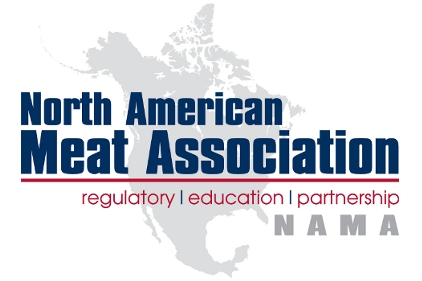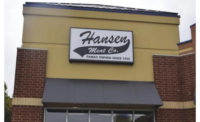The National Meat Association (NMA) and the North American Meat Processors Association (NAMP) joined together to help meet the demands of change by establishing a bold, entirely new association: the North American Meat Association (NAMA).
The leaders of both organizations saw an industry that was faced with increased regulations, consumers with new expectations about animal welfare and a healthy diet, and a changing source of supply.
This year, our industry experienced media attacks on LFTB technology; the negative reaction to beta agonists in Taiwan was making the news; and we moved toward a showdown with China and the EU on ractopamine at CODEX. These technologies, as well as other technologies, are still ripe for attacks by our critics. Our need to be prepared continues.
The calendar year also is seeing movement toward harmonizing meat cut nomenclature between the U.S. and Canada, on which NAMA is taking a leadership role with its 50-year experience in producing the Meat Buyer’s Guide®. Plans are in the works for a pilot program to reduce or eliminate re-inspection every time our products move from the U.S to Canada, or from Canada to the U.S.
The industry in Mexico and the Mexican government are working to become equal partners in North American trade.
Those were challenges NMA and NAMP leaders thought could best be handled by a truly North American meat industry organization, with members throughout the U.S., Canada, Mexico, and other countries where today’s business is being done. They created NAMA, which consolidated the operations of NMA and NAMP on July 1, 2012.
With the North American market becoming increasingly intertwined, an industry association needs a presence in Washington, D.C., Ottawa and Mexico City. NAMA is developing a larger footprint and expanding our resources in the U.S. and Canadian capitals, and we’re working to improve our influence in Mexico.
Focusing on the fast-growing regulatory situation in the U.S. requires a constant presence in Washington, to make sure our industry has a strong voice in developing new regulations and implementing existing ones. It’s also important that the impact of the rules and regulations are accurately transmitted to meat packers and processors.
To help meet those in-plant regulatory challenges, NAMA provides three full-time staff members with extensive supervisory FSIS experience, as well as a regulatory analyst with six years of association experience. Matching the work schedules of many companies in the meat business, these four staffers offer services 24 hours a day, seven days a week.
NAMA’s North American presence is aided by OFW Law in Washington, D.C., and Robert de Valk, our Canadian Government Affairs Representative and president of de Valk Consulting, a respected food regulatory consulting practice in Ottawa.
To compete for that “share of voice,” the consolidation of NMA and NAMP created a NAMA Political Action Committee with a broader base that can raise more money to support the work of friendly members of the House and Senate Agriculture committees who understand the interests of meat packers, processors and related industries.
For several years, Canadian and U.S. officials have worked hard to make their regulatory processes consistent, a process that will streamline trade between the two countries. The same work is being done with Mexico.
The growth of workplace issues — especially worker safety and labor relations — and the impact federal organizations such as OSHA will continue to have on the way we do business. NAMA members are working with the law firm of Alaniz & Schraeder of Houston, Texas, to tap into its nationwide practice helping management solve labor-relations and employee problems.
Leading industry experts like Dr. James Marsden, Regent’s Distinguished Professor of Meat Science at Kansas State University, have consistently pointed out that improvements in food safety must be one of the foremost pursuits of any food processors.
Recent recalls of meat, fruits and vegetables underscore their concerns and prove that the battle against pathogens will never be completely won. We believe that an ongoing educational program that updates the industry regularly on the latest advances in food safety is critical to the future of the meat industry.
We’re working with other trade organizations in all species to develop and promote a heavy schedule of seminars and conferences designed to keep everyone ahead of the curve on the rapidly growing technologies that can help improve food safety. We just finished our E. coli conference in Chicago. We will conduct webinars throughout the year on specific issues like HACCP, the FSIS Public Health Inspection Service (PHIS), and other food-safety and regulatory issues.
NAMA also offers the industry great networking opportunities at its two major conferences a year. Join us and learn more at NAMA’s Outlook Conference Oct. 24-27, in San Antonio, Texas; and NAMA’s MEATXPO and Annual Conference, Feb. 10-13, 2013, in Las Vegas.
Understanding how to run a business more profitably is a difficult proposition for even the best-staffed operations. To help, NAMA offers its Modified Associate Consultants and College of Experts®, independent authorities in areas such as humane handling, inspection issues, import/export, labeling and marketing.
It is reaching out to the industry’s immediate foodservice customers through its Center of the Plate Training®program and its partnerships with culinary associations.
NAMA is providing innovative, comprehensive strategic leadership in a fast changing industry.
NAMA’s Strategic Planning Committee met in September and is building on the successes of NMA and NAMP to lead the industry in the years and decades ahead.
Soon, NAMA will announce bold new leadership on education and research. It is partnering with other associations in innovative ways that have never been done before — and which need to be done if our industry is to succeed.
This is what NAMA is and what we do. It is our value proposition.




Report Abusive Comment